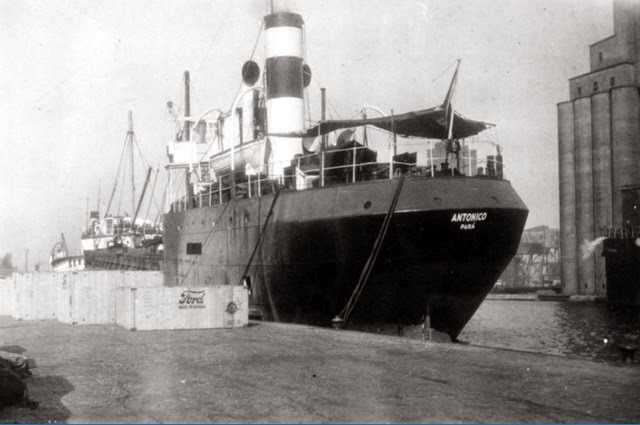SHIPS HIT BRAZIL 33 - BRAZILIAN SHIPS LOST
4)ANTONICO U-156
.jpg)



Built: 1919
Tonnage: 1,243 tons
Cargo: Asphalt in bulk and boxes containing bicycles
Sunk 28 SEP 42 by U-156 on pos. 05º30"N 53º30"W
16 Dead
24 Survivors
The cargo in Belém and the beginning of the voyage: The ship, commanded by Captain Américo de Moura Neves and with 40 crew on board. The vessel had departed from the port of Belém in Pará, in front of quayside 11, in the afternoon of September 17, 1942, outbound to Paramaribo, carrying asphalt for construction of the airffield in that city and a cargo of bycicles in crates. When the shipment was over, the crew sailed and set off in front of the island of Mosqueiro, about 18 miles from Belem, waiting for the harbor pilot who would lead the Antonico and his crew to the North Bar. The same took them through the straits of Breves (channels formed by the islands of the Marajó Archipelago, intermediaries between the Amazon River and its tributary, the Tocantins River) for the purpose of supplying the ship with fuel, but there was not any fuel oil at Belem, then ship boilers were converted to burn firewood).
Under Captain Américo Neves, the voyage continued along the Rio Oiapoque, where the ship had been supplied with more firewood. During this time the captain ordered the crew to carry out rescue drills. In a town called Clevelandia, the captain, two pilots, and the engineer decided to visit the city. Upon returning from the tour, one of the crew alerted them that there was a submarine in the vicinity.
However, already inside the boats, feeling themselves safe, the men were surprised when the submarine artillery, directed by the lieutenant Markle, was beamed to them. Then Commander Wiebe gave the order to shoot killing sixteen of the 40 men crew, including Captain Américo Neves. This action was probably the result of a decision taken by Hitler after the Laconia Incident, an event in which German submarines were attacked by US planes when they attempted to rescue Italian shipwrecked, who were being taken prisoner aboard that British ship. From then on, the order was for the submarines not to give any assistance to survivors.The survivors, most of them wounded, fearing a hostile treatment of the French faithful to the Vichy government, avoided Devil's Island, the closest to the sinking site, to land on a deserted beach in Hatters village. There they were medicated and transferred clandestinely to Suriname, where the most serious wounded were hospitalized.



